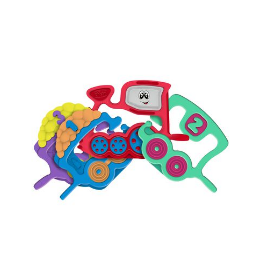
In the fast-paced world we live in, finding ways to promote healthy development in children is a top priority for parents. Interactive kids toys play a vital role in this journey, especially for children under three years old. During this critical developmental stage, children are not just playing; they are learning, exploring, and acquiring essential skills. Here’s why interactive toys are essential for skill development in young children and how they contribute to holistic growth.
Understanding Interactive Toys
Interactive toys are designed to engage children actively, encouraging them to explore, experiment, and interact. These toys often feature sounds, lights, textures, and movable parts that stimulate a child's senses and curiosity. Examples include musical instruments, shape sorters, stacking toys, and activity centers. The hands-on nature of these toys allows children to engage in play that is both fun and educational.
Promoting Cognitive Development
1. Problem-Solving Skills
Interactive toys challenge children to think critically and solve problems. For instance, shape sorters encourage kids to identify different shapes and figure out how to fit them into the corresponding holes. This process not only sharpens their cognitive abilities but also enhances their understanding of spatial relationships and cause-and-effect.
2. Language Development
Many interactive toys incorporate verbal instructions, songs, or sound effects that promote language acquisition. For example, toys that sing songs or recite phrases can help toddlers learn new words and concepts. Engaging with these toys often leads to parents and children interacting verbally, further supporting language development through conversations, storytelling, and role-play.
Enhancing Motor Skills
1. Fine Motor Skills
Interactive toys often require children to manipulate small objects, press buttons, or pull levers, which strengthens their fine motor skills. Toys such as stacking rings or pegboards help children develop hand-eye coordination and dexterity, laying the foundation for more complex tasks like writing and drawing later on.
2. Gross Motor Skills
Many interactive toys encourage physical movement, which is crucial for developing gross motor skills. Toys that require children to push, pull, or climb promote balance, coordination, and overall physical fitness. For instance, ride-on toys not only provide fun but also encourage toddlers to practice walking, balancing, and steering.
Supporting Social and Emotional Development
1. Encouraging Interaction
Interactive toys often involve multiple players, fostering social interaction. Children learn to share, take turns, and collaborate while playing with friends or siblings. These experiences are vital for developing social skills and understanding emotional cues, helping children navigate relationships with peers.
2. Building Confidence
Successfully engaging with interactive toys boosts a child’s confidence and self-esteem. When children figure out how to make a toy work or achieve a specific goal, they experience a sense of accomplishment. This positive reinforcement encourages them to explore further and take on new challenges, fostering a growth mindset.
Fostering Creativity and Imagination
Interactive toys often encourage imaginative play, allowing children to express themselves creatively. Toys that involve role-playing, like play kitchens or tool sets, enable children to explore various scenarios and act out different roles. This type of play is essential for developing creativity and helps children understand the world around them.
Choosing the Right Interactive Toys
When selecting interactive kids toys for children under three years old, consider the following tips:
- Age Appropriateness: Always check the recommended age on toy packaging. Toys designed for older children may have small parts or complex features that could pose safety risks for younger kids.
- Safety Standards: Ensure that the toys meet safety regulations and are made from non-toxic materials. Look for labels indicating compliance with safety standards such as ASTM or EN71.
- Variety of Stimuli: Choose toys that engage multiple senses, including sight, sound, and touch. This variety helps children develop more comprehensively.
- Durability: Opt for toys that can withstand rough play, as toddlers can be tough on their belongings. Durable toys last longer and provide more value.
- Open-Ended Play: Select toys that encourage open-ended play, allowing children to use their imagination and creativity. Blocks, art supplies, and dress-up clothes are great examples.
Conclusion
Interactive kids toys are more than just playthings; they are essential tools for developing critical skills in children under three years old. From enhancing cognitive and motor skills to fostering social interactions and creativity, these toys provide a foundation for healthy development. As parents and caregivers, choosing the right interactive toys can create enriching experiences that help children thrive during their formative years. By understanding the importance of these toys, you can support your child’s growth while making playtime an enjoyable and educational adventure!
